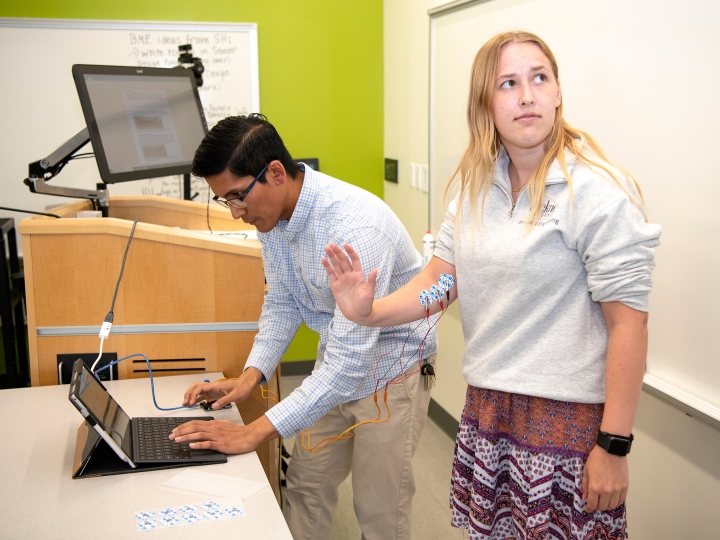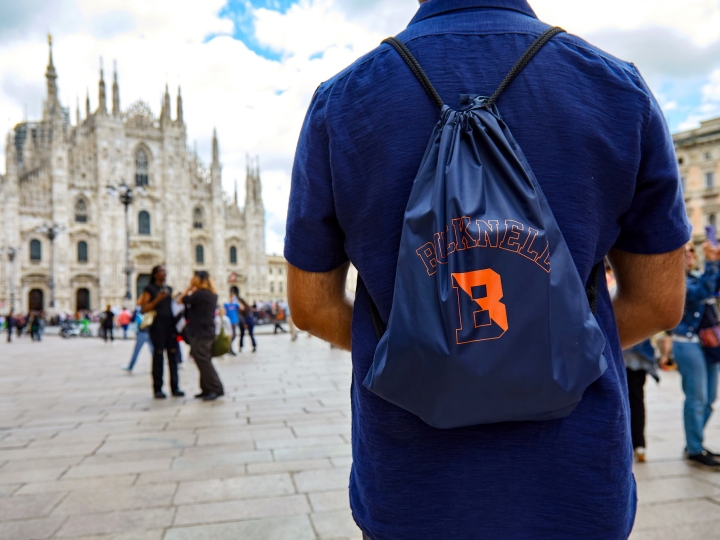Engineering Child's Play
June 18, 2015
Kids can be finicky customers.
If a toy doesn't capture their developing attention and keep them engaged, it will be left on the shelf of the store, or quickly consigned to bottom of the toy box. Toy engineers must consider the many ways a child might play with their product and how to keep them safe when they do so.
Bucknell engineering students took up that challenge in the second annual Bucknell Fabrication Workshop (BFAB), partnering with local toyshop owner Tabitha Geise to develop prototype playthings.
Supported by a $1-million grant from the Kern Family Foundation, BFAB brought 14 Bucknell undergraduates back to campus the week before Commencement for a six-day immersive primer in simple and practical prototyping skills. Led by engineering professors Eric Kennedy, Nate Siegel and Donna Ebenstein, the workshop challenged students to develop prototype toys for Geise's business, the Purple Platypus, along the way teaching participants the basics of 3-D printing, soldering, Arduino circuit board programming and other tools to quickly make ideas in their heads into real products.
"This is a great opportunity for me to learn to do new things and make sure I can apply the things I've learned in class to the real world," said Nancy Ingabire Abayl, a sophomore doing a 5-year program in civil engineering. "Engineering is not about words; it's about work. It's about putting theory into practice. You should know how to do it."
While the projects BFAB students took on might be simple — students practiced soldering by building speakers for their smartphones and learned Solidworks 3-D CAD software and Arduino programming by designing a toy racecar — Kennedy said building something with their bare hands can be a transformative experience for young engineers.
"We want to empower these students, so if they've got an idea, they know how to approach that idea in terms of actually building it," said Kennedy, a professor of biomedical engineering. "Engineering projects benefit when everyone has a voice and is able to lend their expertise and their background. The next time these students do a group project, we want them to feel that they've got expertise and a skillset that matches their ideas."
"I've realized over these couple days that even though we might not have done something like SolidWorks or Arduino before, if we are willing to spend a couple of hours we can pick it up pretty quickly because of the background we already have," added Yash Bhutwala '17, a computer science and engineering major. "This experience will allow me to make prototypes in the future — I can see myself doing that on SolidWorks."
This year, BFAB not only gave students a chance to hone their prototyping skills, but also offered experience designing a product to meet a client's needs. Geise gave students a tour of her toyshop and supplied practical advice about what works and what doesn't in the toy industry and Bucknell alumni from management consulting firm Accenture offered students advice in refining their prototypes and product pitches.
"I'm very passionate about the store and to share that with the students and watch them work was priceless to me," Geise said. "Sharing their passion to design and engineer is exactly how many new products develop and that was something outstanding to be a part of."
"Tabitha provided a closer connection to the customer," added Siegel, a professor of mechanical engineering. "She has boots on the ground selling toys and could talk about what works and what doesn't. She lends perspective that we don't have and she can help connect what they're doing with the ultimate application, a consumer product."
For their final projects, the students put Geise's input and their newfound prototyping skills to work devising prototype toys.
Some enhanced existing toys and games with educational components to make them more intellectually stimulating. Aleksandar Antonov '17 and You Jin Park '16 created an add on to the game Suspend with a kit that allows players to make their own custom pieces, while Nathan Raeker-Jordan '18 and Brian Kerlin '18 developed Trivia Risk, a variant of the popular board game in which players must answer questions about the geography and cultures of countries represented on the game board.
Other students envisioned all new toys to capture children's curiosity. Bhutwala and Emily Fricke '18 made a build-your-own-telescope kit to teach children about lenses, while Emma Bertram '18 and Alex Breakstone '17 developed a play mat for infants and toddlers with 3-D landmarks to familiarize the children with world cities.
"I've studied the neuroscience aspect of toys by taking a class on learning, so I enjoyed building toys," said Bertram, a biomedical engineering and neuroscience double major. "It goes back to the whole reason I'm in engineering. Instead of just thinking about how a toy is going to affect the baby's brain, it's cool to actually go and build it."

